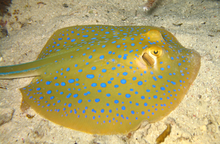Talk:Stingray
| This is the talk page for discussing improvements to the Stingray article. This is not a forum for general discussion of the article's subject. |
Article policies
|
| Find sources: Google (books · news · scholar · free images · WP refs) · FENS · JSTOR · TWL |
| Archives: 1Auto-archiving period: 730 days |
| This It is of interest to the following WikiProjects: | |||||||||||
| |||||||||||
Wiki Education Foundation-supported course assignment
![]() This article is or was the subject of a Wiki Education Foundation-supported course assignment. Further details are available on the course page. Student editor(s): Nsabo, Dfish21, Burner112, AAMHH.
This article is or was the subject of a Wiki Education Foundation-supported course assignment. Further details are available on the course page. Student editor(s): Nsabo, Dfish21, Burner112, AAMHH.
Above undated message substituted from Template:Dashboard.wikiedu.org assignment by PrimeBOT (talk) 10:14, 17 January 2022 (UTC)
Wiki Education Foundation-supported course assignment
![]() This article is or was the subject of a Wiki Education Foundation-supported course assignment. Further details are available on the course page. Student editor(s): Jdlc700.
This article is or was the subject of a Wiki Education Foundation-supported course assignment. Further details are available on the course page. Student editor(s): Jdlc700.
Above undated message substituted from Template:Dashboard.wikiedu.org assignment by PrimeBOT (talk) 10:14, 17 January 2022 (UTC)
Additions
Some of my colleagues and I were thinking about adding sections on the following criteria. What do you all think about our topics of choice?
- Venom. The venom of a stingray is held in its spine. Stingrays spine can grow in the womb. The amount of toxicity varies depending on the type of stingray. The level of toxicity decreases as the stingray reaches maturity which suggests there is less of a biological need for it as it grows in size.
- Locomotion. The stingray uses Median Paired Fins (MPF) opposed to undulations where the caudal fin is the source of locomotion. MPF provides quicker and more accurate movement needed for shallower waters.
- Respiratory System. Discuss how string rays perform gas exchange. Make note of the spiracle and its usefulness for organisms such as the ray. Also, provide labeled pictures of different structures relevant to the respiratory system.
- Jaws and teeth. Discuss the the mechanics of the cartilaginous jaws and teeth (essentially rows of flat plates) in relation to feeding habits of the sting ray and include supplementary images of the jaw and teeth.
-- I think all those would be interesting additions. Jack Waugh (talk) 18:56, 4 October 2023 (UTC)
References
Kardong, Kenneth V. Vertebrates: comparative anatomy, function, evolution. 7th ed., McGraw-Hill Education, 2015. Pp 213-250
Wang, Y., Tan J., Zhao D. 2015. Design and Experiment on a Biomemetic Robotic Fish Inspired by Freshwater Stingray. J. Bio. Eng. 12: 204-216.
Enzor L, Wilborn R, Bennett W. Toxicity and metabolic costs of the Atlantic stingray (Dasyatis sabina) venom delivery system in relation to its role in life history. Journal Of Experimental Marine Biology & Ecology. December 2011;409(1/2):235-239.
Kirchhoff K, Klingelhöfer I, Dahse H, Morlock G, Wilke T. Maturity-related changes in venom toxicity of the freshwater stingray Potamotrygon leopoldi. Toxicon: Official Journal Of The International Society On Toxinology [serial online]. December 15, 2014;92:97-101.
Kolmann, Matthew A.; Crofts, Stephanie B.; Dean, Mason N.; Summers, Adam P.; Lovejoy, Nathan R. (2015-12-01). "Morphology does not predict performance: jaw curvature and prey crushing in durophagous stingrays". Journal of Experimental Biology. 218 (24): 3941–3949. doi:10.1242/jeb.127340. ISSN 0022-0949. PMID 26567348.
Kolmann, Matthew A.; Welch, Kenneth C.; Summers, Adam P.; Lovejoy, Nathan R. (2016-09-14). "Always chew your food: freshwater stingrays use mastication to process tough insect prey". Proceedings of the Royal Society B: Biological Sciences. 283 (1838). doi:10.1098/rspb.2016.1392. ISSN 0962-8452. PMC 5031661 . PMID 27629029
Image

I think this one is good to be associated in the page. Since it is already overcrowded with irrelevant ones, I will just post it here. --βritandβeyonce (talk•contribs)
Removal of "largest stingray" section
I have removed the following section: Perhaps the largest stingray ever found weighed almost 1500 kilograms (3300 pounds) and measured over 5 meters (16.5 feet) in width . It was caught by fishermen near Hainan Sanya in China."Giant 3,300 Lbs Stingray Caught by Local Fisherman." Weird Asia News 04 Aug. 2008. 26 Feb. 2009 <http://www.weirdasianews.com/2008/08/11/giant-3300-lbs-stingray-caught-by-local-fisherman/> The sourced article does not list a species and the ray in the article looks just like a manta ray which to my knowledge is the only species to approach such a size.
typo
"stings" should be "stingers" in the first section of the article
This edit request has been answered. Set the |answered= or |ans= parameter to no to reactivate your request. |
Request: In section "Feeding behavior and diet" please change "Since their mouths are on the side of their bodies" to "Since their mouths are on the underside of their bodies"
Description of edit request: changing word 'side' to 'underside' to increase accuracy of description.
- B-Class vital articles
- Wikipedia level-4 vital articles
- Wikipedia vital articles in Biology and health sciences
- B-Class level-4 vital articles
- Wikipedia level-4 vital articles in Biology and health sciences
- B-Class vital articles in Biology and health sciences
- B-Class Fishes articles
- High-importance Fishes articles
- WikiProject Fishes articles
